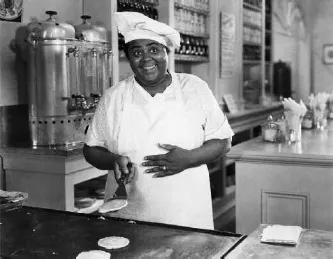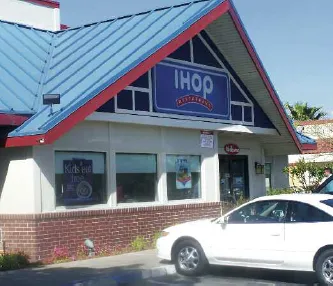![]()
1
Comfort Food
In the western world, pancakes are among the most cherished and quintessential of comfort foods, especially when served for breakfast. This is because they are utterly indulgent and completely predictable. Pancakes taste best consumed in periods of sloth on protracted weekend mornings. They must be savoured without hurry or premeditation, ideally in dressing gown and slippers, at the kitchen table or maybe even in bed, and preferably in excess, just to the brink of nausea. The combination of grease, syrup and flour should create just the right leaden effect on the stomach so as to prevent any further activity for several hours. Park the numb and bloated carcass in a comfortable chair with a news-paper or in front of the TV: the only way to deal with the postprandial stupor. This experience defines comfort.
Such pancakes are supremely comforting when prepared by a loved one. Few foods better epitomize contented domestication. What other food can nestle berries or chocolate chips in a smiley face, or better yet be cooked in a Mickey Mouse mould or poured in the form of the letter B?
Pancakes are normally made from fresh ingredients as they are so simple to prepare but, increasingly, those pressed for time or talent use dry mixes, chilled batters in a carton, or even frozen varieties that are popped in the toaster. But for a pancake to be considered homemade, there must be at least a suggestion of actual mixing and frying. Aunt Jemima has recently begun marketing a pancake mix in a plastic jug to which one only adds water, creating an instant batter, removing the mixing bowl step beloved by Bisquick fans, yet still lending the impression of making the pancakes from scratch. That is, it satisfies parents and children that this is something cooked especially for them, of a higher order and status than a box of cold cereal.
Apparently even dogs like pancakes, as this image of Cary Grant shows.
Aunt Jemima herself is a perplexing image of comfort, recalling, despite her many makeovers, an antebellum slave mammy, expert in the kitchen and ready at any time to satisfy the hunger pangs of her master and children. Understandably the company has distanced itself from this association, and Jemima now sports a neat coiffure and pearl earrings, sure signs that she is a middle-class black woman, perhaps a working grandmother, serving her own family. In the early twentieth century, however, the association with slavery was very real and Americans seem to have enjoyed buying products they could imagine were fixed by expert black cooks. Blackface minstrels and cakewalks were not yet seen as degrading, at least by most white consumers. Aunt Jemima was first used by Chris L. Rutt and Charles Underwood in St Joseph, Missouri as a vehicle to market their instant pancake mix, which appeared in 1889. Though their Pearl Milling Company went bankrupt, the pancake recipe and Aunt Jemima were bought by the R. T. Davis Milling Company. Davis decided to use a real live woman, one Nancy Green, born into slavery, to be Aunt Jemima in the company’s advertisements. She cooked pancakes at the Columbian Exposition at Chicago and drew enormous enthusiastic crowds. She even entertained the throngs at Disneyland with her pancake skills. In 1925 Quaker Oats bought the product and its trademark. Green had died a few years earlier in a car accident but there were replacements for her for many decades.
The history of the advertising image of Aunt Jemima is fascinating in itself, but the irony of selling a mix as something homemade seems to have escaped most people, as it still does. Perhaps the idea was much the same as with instant cake mixes: after adding eggs to the dry ingredients, the cook is left with the impression of having actually made something. With pancakes, it is cooking them from a batter that seems to constitute an authentic culinary accomplishment.
Louise Beavers as housekeeper Delilah Johnson in Imitation of Life (1934). Loosely modelled on the experience of the woman who portrayed Aunt Jemima, the film explores how the image of black slave women was appropriated to sell pancake mix.
What is more perplexing is why the Aunt Jemima icon is still used to sell pancakes. Clearly in the early twentieth century she was a character meant to evoke the idyllic Old South, where the black woman was portrayed as happy to serve as a slave to the white family and to comfort them in any number of ways, including going through the labour of making pancakes so that mother did not have to. The fact that she was plump and jolly also assuaged any guilt over the real horrors of slavery. The Slave in a Box, as M. M. Manring has called Aunt Jemima in a book of the same name, does precisely the same thing. She (i.e. the company) does all the work so you can enjoy your leisure and comfort. The box of pancake mix serves the same function as the black slave.
In the twentieth century this product and many others were marketed as ‘convenience’ foods. Somehow consumers were convinced that the effort of mixing flour, eggs and milk was excessive and that it saved time if you could just pour a dry mix into a bowl. The combination of comfort and convenience reached perhaps the pinnacle of folly in an invention designed to make pancakes automatically at home. On 28 April 1958 Time magazine featured an automatic pancake baker designed by the Polarad Electronics Corporation on which ‘a hopper at the top holds the batter, releases enough for one pancake at a time to an electronically heated griddle’. The machine then flips it and the ‘finished pancakes thus drop onto a platter continuously’. The inventor hoped this would relieve his harried wife from the ongoing effort of plying their voracious hoard of children with pancakes.
We must wonder how such a simple food could retain the association with comfort, despite all these modern conveniences. The answer must be that pancakes are one of the first foods given to children after they are weaned from pap and mush and thus are indelibly associated with childhood and pleasant memories. Not surprisingly they also feature prominently in children’s books. Among all the foods mentioned by children’s authors, none is more pervasive than pancakes – green eggs and ham notwithstanding. There is a very good reason for this: pancakes are among the simplest, tastiest and most approachable of foods that can be introduced at a young age, hence the deep nostalgia among grown-ups and reveries of happy pancake-filled youth. The pancake is the comfort food that no vegetable or breakfast cereal could ever hope to be. A true comfort food must be warm and fresh and preferably laboured over by a loved one especially for you. Remember, this is how the witch in Hansel and Gretel is able to lure the children into her house: not only is the roof made of cake and the windows of sugar, but she feeds them milk and pancakes, and only after gaining their trust by cooking for them, does she lock up Hansel and reveal her plan to eat the children.
Natalie Wood whips up a pancake breakfast, 1957.
Knowing full well that children can relate to pancakes, a spate of books includes them – Curious George makes pancakes, If You Give a Pig a Pancake is a sequel to the popular mouse and cookie book and there are dozens of lesser-known titles. This is nothing new: ‘Little Black Sambo’, though now obscure thanks to illustrations and subject matter deemed offensive, was hugely popular over a century ago. Set in India, the story involves a young boy, Sambo, fending off a series of tigers by giving them each an article from his dashing new wardrobe. The tigers end up arguing over which is the most dapper, finally chasing each other around a tree with such vigour that they melt into ‘ghi’ (clarified butter). The butter is then used by Sambo’s mother, Mumbo, to make pancakes. Sambo eats no less than 169. That’s contentment for you.
The other locus for pancake comfort, interestingly enough, is outside the home. The passion for pancakes was satisfied in a sheer deluge of so-called pancake houses that began to appear in the 1950s. The Original Pancake House founded in Portland, Oregon in 1953 was among the earliest of these and is still in business today with 90 franchises from coast to coast. But it is minuscule compared to the pancake house giant: the International House of Pancakes, or IHOP, founded in Toluca Lake, a suburb of Los Angeles, in 1958. Numerous national and regional franchises followed, it was traded publicly by 1961 and then went fairly berserk buying up businesses over the next decades, including non-food companies. Today the company appears to have divested these to refocus on pancakes. Today most US cities have one if not several IHOP franchises, with over 900 outlets thriving nationally.
The appeal of most pancake houses, judging from the typical decor, appears to derive from nostalgia for the good old times when people ate simple hearty food in great quantities before they went out to chop firewood or plough the fields. Red checked gingham, at least at the beginning, was the sign of traditional home cooking, despite the fact that most people drove up in cars and allowed strangers to prepare their ‘grand-slam’ breakfasts. IHOPS all had a very distinctive A-frame with a blue roof and a colonial-looking electrified sign. Many shops intentionally capitalized on the fashion for things colonial in the 1970s, nicely coinciding with the bicentennial celebrations and a surge of patriotism, fostered perhaps in the wake of so much political disaffection during the Vietnam War. In other words, like traditional family values and traditional American style at the time, albeit in a highly kitschy 1970s interpretation, the pancake house became a bastion of comfort with an overtly conservative message. Hippies might be drug-soaked and sexually liberated, but good Americans take their families out to eat pancakes. At least this seemed to be the message that came through in the advertisements of the giant pancake houses.
A modern incarnation of the International House of Pancakes in Stockton, California.
There have also been loyal patrons of the independent local greasy spoon, where one would at least know the waitress and perhaps even be able to claim a regular spot with a cup of joe and a short stack of flapjacks brought without asking. Smaller independent pancake houses are to be found everywhere in the US. They blend fairly seamlessly into other generic breakfast joints, such as Denny’s, which is actually the largest breakfast chain in the US, and has roots in California in the mid-1950s. Diners are typically places where one can get breakfast pancakes any time of day, and they are an older institution than the pancake house. Diners usurped some of the pancake house’s function, particularly involving comfort food that can be ordered any time of day, even late at night after a raucous night on the town.
The pancake craze was not merely a US phenomenon. The Netherlands is also riddled with cosy pancakes houses, though there they are more like family restaurants, often not even open in the morning for breakfast. In Britain, the phenomenon is not quite as widespread, though a...





